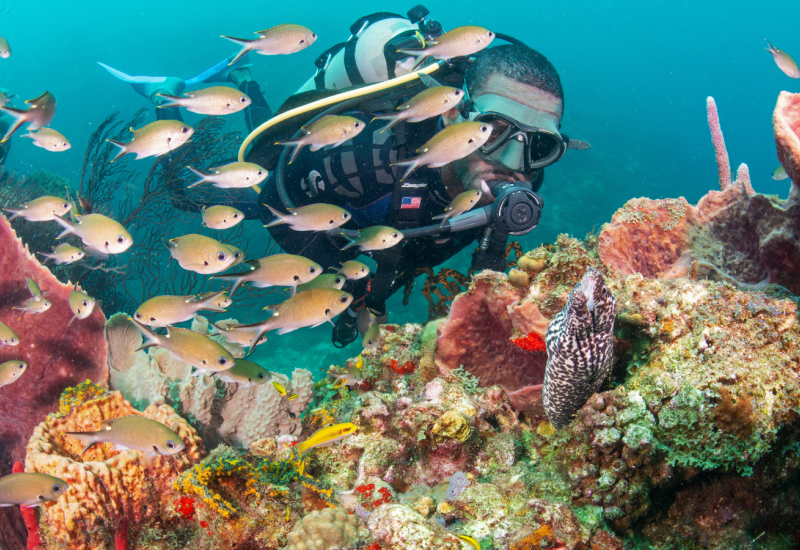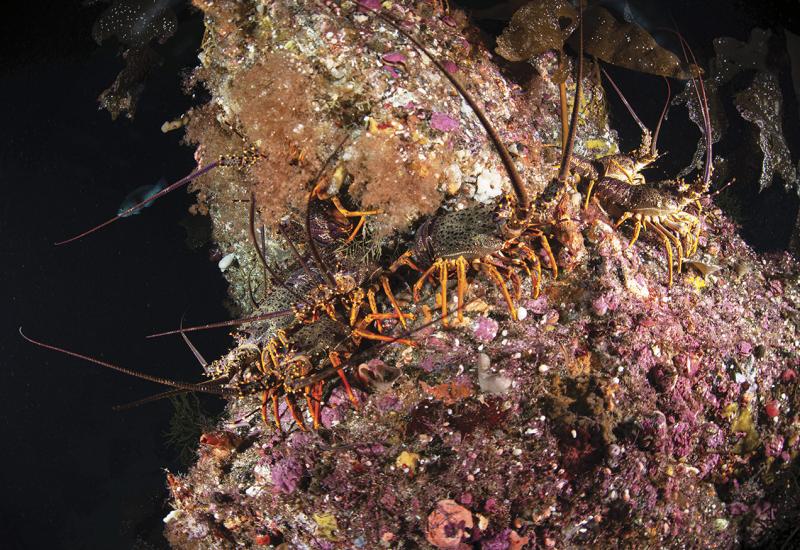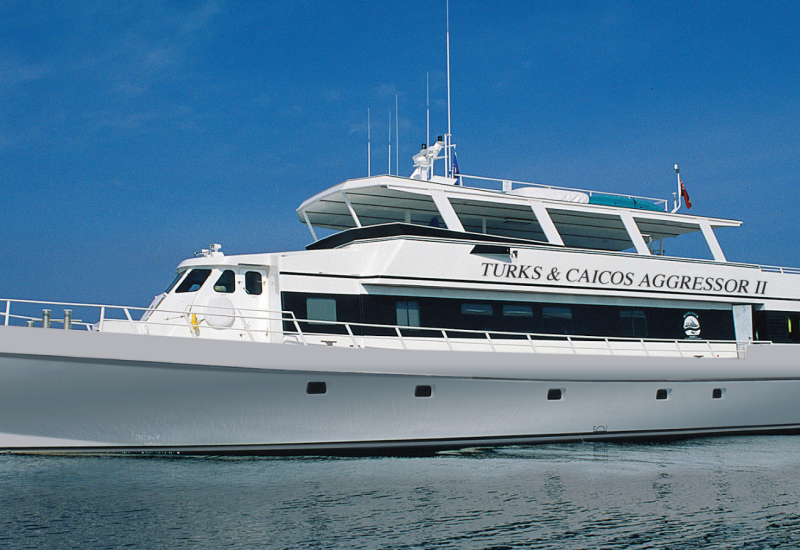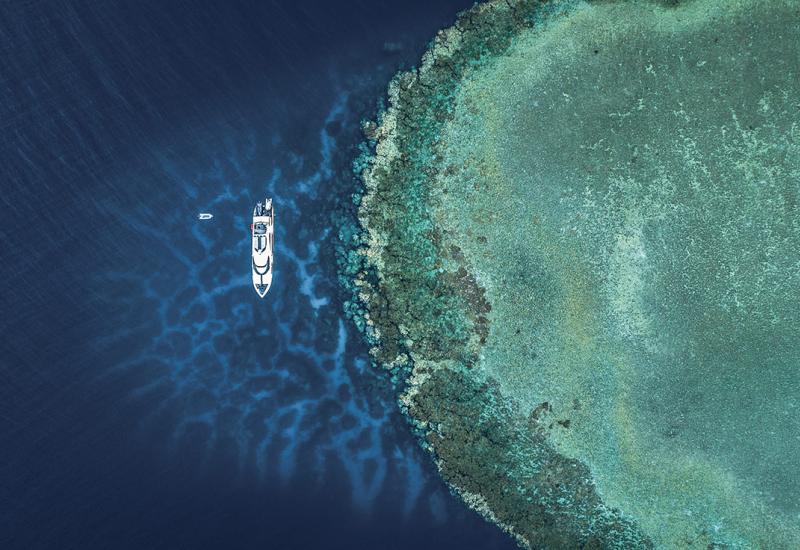Scuba Diving with the most Terrifying Creatures in Brazil's Amazon River

Brandon ColeIn Brazil, the local word for anaconda is Sucuri — and they can grow up to 25 feet in length. In the mighty Amazon, the vast spiderweb of writhing rivers and impenetrable bogs live vicious piranhas, prehistoric reptiles, mysterious shapeshifters and other fearsome creatures.
Brazil is full of monsters. In the mighty Amazon, the vast spiderweb of writhing rivers and impenetrable bogs live giant snakes, vicious piranhas, prehistoric reptiles, mysterious shapeshifters and other fearsome creatures. For intrepid divers, it’s the modern equivalent of the first Western explorers’ grand adventures. Twenty years into my career as a marine photographer, it was high time to try something new: fresh water. Where better than Brazil? My chance for an epic journey of discovery.
View all 15 photos
Meet the Sucuri Snake
The tape reads 7 meters. Could that be right? It’s difficult to wrap my brain around this number. Twenty-three feet. The snake is almost four times as long as I am tall. Its slick chestnut scales glisten with an iridescent sheen, shifting from metallic blue to green to yellow. Beautiful. A forked tongue flicks like a bolt of purple lightning. Sinister. Thick as a tree trunk and no doubt powerful enough to squeeze the life from me, the green anaconda is — at least presently — calm. Stretched out along on the silty bottom of the Rio Formoso, this living, breath-holding throwback to the age of the dinosaurs is just lying there.

Brandon Cole"The snake is almost four times as long as I am tall. Its slick chestnut scales glisten with an iridescent sheen, shifting from metallic blue to green to yellow. Beautiful. A forked tongue flicks like a bolt of purple lightning. Sinister."
I, however, am anything but calm. My breath explodes through my regulator as I kick madly into the strong current. Fighting against the drag of my camera, it’s a struggle just to hold position above the surreal scene. Confirming the mind-boggling 7-meter measurement for a third time, the scientists who have led us here finally coil their measuring tape, and with wide eyes, give me the go-ahead to move in for pictures. My wife, Melissa, ever the brave, curious sort, beats me into position and glides in close to the sucuri (the native word for anaconda) for a proper inspection — fascination obviously trumping fear.
In retrospect, the whole experience seems otherworldly — a stretch to believe — which suits us perfectly. After all, the sole purpose of this expedition had been to shake things up, to satisfy the urge to submerge in a foreign environment radically different than the familiar embrace of ocean currents and the coral reef. I am energized to be out of my element. This world-encircling serpent is a testament to the fact that there’s a great deal of aquatic adventure awaiting outside the oceans, inshore, in the água doce of Brazil’s feral rivers and lakes.

Brandon ColeRapids in the Rio Olho d’ Agua force a short portage to reach what our guide calls the “sand volcano.” Like an underwater Krakatoa, the jet of warm water gushing from the Earth’s core boils and churns the sand in an endless eruption.
Underwater Sand Volcanos in Rio Olho d’ Agua
Underwater photo shoots in Rio Olho d’ Agua, a spring-fed river in the southwestern Bonito region of Brazil, begin with a forest trek. Monkeys run amok through the thick canopy, while vivid toucans I’ve previously seen only on cereal boxes glide overhead. Despite carrying only cameras and snorkeling gear, I’m sweating through my wetsuit and looking forward to submersion. The river promises clear water, gentle currents and more than 60 species of fish.
Breaking the surface, I’m mesmerized by the sapphire blue beneath and emerald green above, and try to use my mask like bifocals to take it all in at once, admiring the meeting of two divergent worlds at the waterline. I turn my camera on a piraputanga, a splendid troutlike specimen both colorful and inquisitive, then a school of pacu, which parade past heading upstream while the mellow drift pulls us downriver. A spasm of excited chirping through a nearby snorkel, followed by an urgent tug on my fin, breaks my reverie and swirls me about-face to see my wife pointing toward the opposite bank. I kick at warp speed, angling against the now-building current, just in time to spy a juvenile anaconda disappearing into a thicket of roots and branches. At perhaps only eight feet in length, it’s a baby compared with the monster in the Formoso, but the markings and coloration are impressive. Pity.

Brandon ColeLocal legend claims river dolphins take human form at night to seduce women.
Drifting around the next bend, my disappointment is quickly displaced by a dorado, a muscular fish with armored cheek plates that glow golden. Its pugnacious stare is all predator. Rapids in the river force a short portage to reach what our guide calls the “sand volcano.” Like an underwater Krakatoa, the jet of warm water gushing from the Earth’s core boils and churns the sand in an endless eruption. Beyond, we hunt for giant river otters that can grow to up to six feet long, and the Cuvier’s dwarf caiman, known to haunt a shadowy back eddy around yet another bend, until I’m slammed in the side by a churning wall of cold water. The Olho has merged into the Rio da Prata, the larger parent waterway that continues all the way to the Atlantic, and our journey has ended.

Brandon ColeJacare caimans look a lot like alligators and crocodiles, and they are more closely related to alligators.
Amazon River Dolphins
The boto is not the sexiest of cetaceans. With a boxy, lumpy profile in stark contrast to their cousins’ stereotypical svelte form, and small, beady eyes that appear almost an evolutionary afterthought, the bulbous-foreheaded Amazon river dolphin won’t steal hearts with dashing good looks. But according to local legend, they are capable of a magical metamorphosis. Deep in the wilds of Amazonia, spirits splash in the dark sluggish waterways, and slip silently through tangles of trees half-submerged. The boto shift seamlessly between the realms of myth and reality, playful pink shadows below and mischievous spell-weavers above. Ladies, if an irresistible gentleman in a hot-pink suit comes calling in your dreams — beware.
In the heart of the Amazon Basin of northern Brazil, I slide into the 88-degree water to find three dolphins waiting just below the surface, pointing long beaks straight at me. The visibility is terrible — imagine an agitated cup of coffee with the swirling grounds — but my quarry is close enough to touch, and I lose myself in my viewfinder. As one they tilt their heads to the side (botos are one of the few dolphin species with truly flexible necks), regarding me quizzically, then pirouette and glide away into the gloom. I chase blindly, but it’s they who find me — again and again — materializing from the murk, curious and undeniably charismatic. Whereas the anaconda was aloof, the botos are downright gregarious. As we play hide-and-seek, I meet a number of individuals: smooth grayish calves, pudgy, eight-foot-long adults, and one gnarled oldster covered in scars with peglike teeth worn down to nubs.

ShutterstockBRAZIL MAP
Many of the major cities (Manaus, Rio, Sao Paolo, Brasilia, etc.) can serve international gateways into Brazil. From these hubs, you will likely connect to smaller cities by domestic air or land transport.
Barreling into a snarl of tree branches — the river level is 12 feet higher than normal due to heavy rains — I’m struck with a bright idea. Leading with one extended arm, I dive down into inky blackness until I connect with a soft, cool sludge of decaying plant matter — the floor of the flooded forest. Twisting around, I gaze up from 20 feet, witness to one of the weirdest of sights. It’s as if I’m in a tunnel, darkness pressing in from all sides. I’m staring into an orange-red sky. And pink dolphins are flying through the trees.

Brandon ColeA school of piraputanga, a splendid troutlike specimen both colorful and inquisitive, underwater in Brazil's Rio Olho d’ Agua.
Jacare Caiman
To balance our waterlogged weeks in Bonito and the Amazon, we’ve scheduled an extended surface interval in central Brazil. The Pantanal is the world’s largest wetland, so even though our regs are on holiday, we’re still in contact with água doce. Plenty of it. We travel by plane to Cuiaba, then Jeep, bouncing along the famous Transpantaneira Highway and over sketchy bridges. It’s a rugged road slicing through the heart of this rare flood-plain ecosystem, host to a wide diversity of exotic animal life. It’s the equivalent of an African safari, by boat.

Brandon ColeWith a boxy, lumpy profile in stark contrast to their cousins’ stereotypical svelte form, and small, beady eyes that appear almost an evolutionary afterthought, the Amazon river dolphin won’t steal hearts with dashing good looks.
Snap! I rip the housing out of the water and lunge backward, rocking our little boat perilously. Our guide, Giuliano, gives a knowing smile. Steve Irwin I’m not, neither in reflex — nor bravery. And I certainly don’t possess the ability to charm the caiman that has nearly clamped down on my camera. The Rio Claro — and just about every other river, pond and waterhole in the Pantanal — is filthy with the shifty-eyed reptiles. Some are skittish, but this six-foot jacare is bold — aggressive. Hence, my camera housing dangling from the end of an aluminum pole, poised inches from the caiman’s serrated maw. I’m intent on making pictures, and will use whatever tools and techniques are required. It works brilliantly. I hammer on the remote trigger as I frame the coveted tonsil shot: a mouth-open over/under view. The boat driver stands guard with a stout paddle, poised to deflect a rogue that might decide to leap from the water.

Brandon ColeThe Amazon river dolphin (aka "Botu") has pink coloration because its skin is so thin that you can see its blood through the dermis layer.
Satisfied, we motor down to Porto Jofre and switch to telephoto lenses on tripods. Our quest resumes for new subjects: river otters, countless birds, the giant capybaras rodent and stealthy jaguars. These noble wildcats, normally very reclusive, are often sighted along the banks of the Cuiaba river, and we are lucky to spot many peering out from the dense foliage, lazing along water’s edge. It is the realization of a lifetime dream for us.

Brandon ColeMy wife, Melissa, ever the brave, curious sort, beats me into position and glides in close to the sucuri (the native word for anaconda) for a proper inspection — fascination obviously trumping fear.
Photography Tips for Divers
Photo opportunities in backcountry Brazil are seemingly endless. Impressively sensitive in low light, today’s digital SLRs helped me capture dramatic pictures in dark water. Even with bright sunlight, much of our underwater shooting was at ASA 800 and 1600, something unthinkable until recently. Fill flash is helpful for birds and sloths in the trees, and river otters along shaded riverbanks. Underwater, flash helps with colorful fish on river drifts, but use smaller strobes to ease snorkeling and hiking. Employ ambient light rather than strobes when shooting river dolphins. Consider experimenting with preset color temperatures, which might yield better results than auto white balance. And definitely shoot in RAW for greater color-tuning latitude after capture.

Brandon ColeGreen-winged macaws are one of Brazil’s nearly 1,000 macaw species.
Dive and Travel Info
Brazil is a big place. From the mighty Amazon’s flooded forest in the north, through the Pantanal wetlands in the center of the country, to swift-flowing rivers in the Bonito region, fresh water — água doce — is everywhere. For divers used to the sea, the change in salinity brings with it wild new creatures, new photo subjects, but also new challenges. Boots on the ground are invaluable. Local guides can help navigate linguistic hurdles, keep you safe when it comes to potentially hostile natives (piranhas, caimans, bugs, etc.), and arrange travel, permits, access, and more. To link together far-flung adventures like we did requires lots of logistical planning, patience and energy. It is neither cheap nor easy — but worth it.

Brandon ColeArapaima, one of the largest freshwater fish, can also breathe air.
When to Go: Though there’s no hard and fast rules for when to visit Brazil; for an expedition like ours, we suggest between May and November to avoid what is considered the rainier season.

Brandon ColeBrazil is known for its potentially hostile natives like piranhas, but they make for great underwater photos.
Scuba and Snorkel Operators
Amazonia offers pink river dolphin sessions, jungle tours, and accommodations at the Ariau Amazon Towers Hotel
Bonita
- Drift Snorkeling down the Olho d’ Agua and Rio da Prata
- Scuba diving in Lagoa Misteriosa
- Scuba diving in Abismo Anhumas
- Customized wildlife and photography tours

Brandon ColeThe Pantanal is the world’s largest wetland, so even though our regs are on holiday, we’re still in contact with água doce.
Pantanal
- Wildlife-spotting tours and accommodations on the Rio Claro
- Wildlife-spotting tours and accommodations on the Rio Cuiaba
- Customized wildlife and photography tours
More of the Amazon's Wild Creatures

Brandon ColeGiant river otters that can grow to up to six feet long in the Rio Olho d’ Agua.

Brandon ColeNoble jaguars — normally very reclusive — are often sighted along the banks of the Cuiaba river, and we are lucky to spot many peering out from the dense foliage, lazing along water’s edge.










